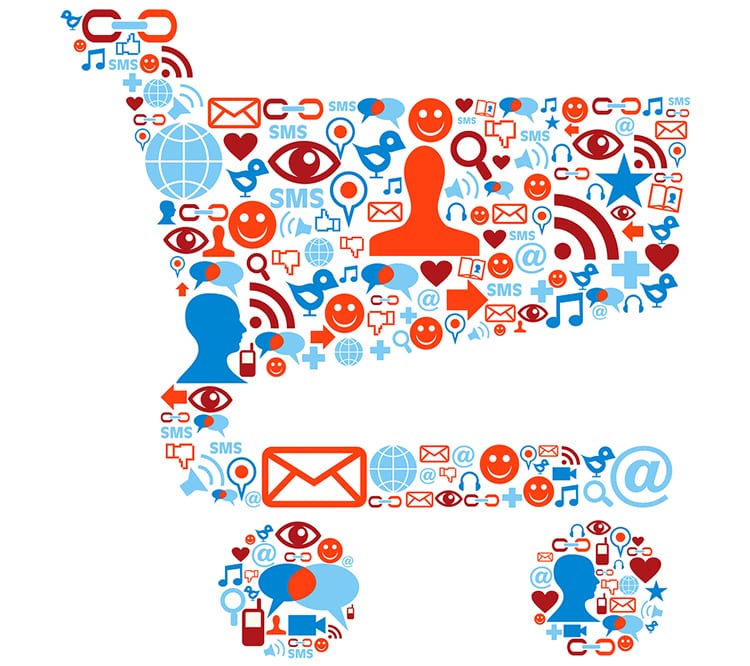E-Tailing in a Social Shopping World: 5 Ways to Win Big

Because of this, plenty of other services are hopping on board.
From Buy Now pins on Pinterest to Sponsored posts on Instagram and Polyvore, a collections-based apparel social media site, e-tailing has become a major trend in the digital world.
Here’s what you need to know about the history of this hot trend, and how you can use it to sell your goods like hotcakes.
Social Commerce is the Future
In the past several years, social media has gone off like gangbusters. Today, more than 79% of web users have a Facebook profile, ad revenues topped $21.57 billion on the site last year, and Facebook-owned Instagram added 100 million users in just six months back in 2016.
As those platforms continue to explode, their functionalities grow right along with them. Once mere social sites designed to allow you to keep up with your crush from high school, these platforms are now digital powerhouses equipped for everything from marketing to shopping.
Here, though, we’re most interested in the latter. As more businesses start selling on Facebook, it’s natural for the ecommerce industry to start paying attention to what e-tailing looks like in a social shopping world. This trend is only going to continue, after all, so it pays to be informed about the current state of social media marketing, and how it ties into digital commerce.
The State of Social Commerce
Because social commerce has developed so quickly, it’s natural to wonder about the history of this phenomenon, and where it stands today.
Here’s what you need to know:
- Facebook ecommerce has become more popular in recent years. In 2017, Facebook’s ad revenue hit $10.14 billion, while Instagram mobile ad revenues hit $4 billion the same year.
- Average order values are going up. Right now, the average customer spends $1.8k on digital shopping annually. This represents a significant increase from just a few years ago.
- The average order on Facebook is $55. If you’re interested in diving into ecommerce on Facebook, this order value provides an excellent platform. It’s higher than the order value on any other site except Instagram, which tops out at $65.
- Social commerce is multi-faceted. While some marketers may assume that social commerce is merely selling an item on a social site, it’s a complex combination of content, community, commerce, context, connection and conversation – all of which come together to create a dynamic experience for consumers.
- Social reviews increase sales on social sites. When it comes to social shopping, positive reviews improve brand perception for 71% of shoppers, and favorable product reviews can increase a product’s price by 9.5%.
5 Tips for Selling on Facebook
Want to dive into Facebook ecommerce head-first? Here are some tips to get the job done in style:
1. Build Your Community
This is sales 101. Before you can push a product successfully, you’ve got to create a sense of community around your product.
This is the one real place that a brick-and-mortar store has an advantage on a digital establishment: the brick-and-mortar has customers walking through the door, and that makes it much easier to create a sense of community.
Don’t worry, though: you can create this sense of community even without a physical home base.
By utilizing Facebook as a platform to share local news, provide information, and connect deeply with your customers, you can build up a trusting and engaged community that makes it easier to sell your goods down the road.
2. Focus on Customer Loyalty
When it comes to selling on Facebook, it’s easy to get tunnel-vision. So many online businesses get incredibly focused on customer acquisition, at the expense of customer loyalty. While acquisition is essential, making sure those hard-earned customers keep coming back is just as necessary.
Don’t forget this fact: boosting your customer retention rate by just 5% can increase profits between 25%-95%.
3. Offer Specials
As much as you can, offer one-off specials to encourage people to “like” your page. This is a great way to earn more followers, and also an excellent way to keep your existing customers engaged and happy.
No matter what you choose to provide, be sure you’re using your Facebook storefront as another distribution point. This will help grow your audience and keep your products moving. Incentives can be especially productive when it comes to engaging new customers.
4. Use Facebook for Customer Service
While it may seem like customer service and etailing aren’t that closely linked, they go hand-in-hand. If you can use Facebook as a platform for extending customer service to your shoppers, you’ll stand a better chance of keeping customers on the platform, which increases the likelihood that they’ll purchase from you through the platform.
5. Promote Across Channels
Selling on Facebook doesn’t mean only using Facebook. Instead, you’ll want to use the platform to create content that you can then share across other platforms, including Twitter and Instagram. When you use other social networking channels to share your Facebook content, you expand its reach and increase the likelihood that it will “land” with customers.
Improving Your Facebook Store
Ecommerce on Facebook can feel like a finely-tuned art. Luckily, it’s possible (and attainable) to break into. By taking a community-minded approach to your Facebook posts and social shopping pursuits in general, you can use the social platform as a launching pad to share your products, expand your customer base, and enjoy better results from your online ecommerce.
Need even more statistics about social commerce? Here’s a detailed infographic that gives you a complete breakdown for 2018.

Share On:







